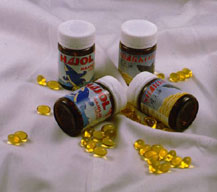Fish oil - November 2009

Fish oil production declined in the first half of 2009. Some 365 000 tonnes were produced by the main fish oil exporting countries, 20 000 tonnes less than in the same period of 2008.
Lower supply of fish oil
Fish oil production declined in the first half of 2009. Some 365 000 tonnes were produced by the main fish oil exporting countries, 20 000 tonnes less than in the same period of 2008. The greatest decline was reported by Chile, while all other major fish oil producers reported relatively stable output. Fish oil prices usually follow the trend in fuel prices quite closely; consequently fish oil prices rose in the second quarter of the year, following fuel prices upwards. Further price hikes are likely in coming months.
Record high fish oil exports from Peru
According to national statistics, Peru produced almost 200 000 tonnes of fish oil in the first half of 2009, 11% more than in the same period of 2008. The increase in production was mainly brought about by higher fat content, as anchovy landings actually declined sharply in the same time period. However, the statistics compiled by IFFO and reproduced below do not reflect this strong increase.
In the first six months of 2009, Peru exported some 132 000 tonnes of fish oil, up 35% from the same period of 2008. The main recipients of this commodity were Belgium (34 000 tonnes), Denmark (25 000 tonnes), and China (17 000 tonnes). These three countries accounted for 60% of total Peruvian fish oil during the first half of 2009. The salmon crisis in Chile led to a reduction in fish oil exports to this country; in the first half of 2009 only 6 000 were imported by Chile.
Compared with the Peruvian production, US fish oil exports are considerably smaller. In the first half of 2009, they reached 22 100 tonnes, slightly below the corresponding 2008 figure. Fishing in the third quarter was good, so US exports of fish oil for the whole of 2009 should be similar to 2008 results.
Fish oil prices increased in the second quarter of the year. However, owing to the extremely low soybean supply to the world market, soybean oil prices exceeded those of fish oil for the first time in seven years. Prices of both commodities are likely to increase in coming months, following the overall price trends of oil commodities.
Later this year the largest-ever study into the health benefits of eating fish will begin. The USD 20 million US-government sponsored exercise is to examine whether fish oil and Vitamin D, or a combination of both, can help prevent heart disease, cancer and a range of other illnesses. The trial will be conducted at the Harvard-affiliated Brigham and Women’s Hospital in Boston and will include a 25% black target group. The study, which is backed by various American health organisations, will look at 20 000 older men and women with no history of heart attacks, strokes or cancer. They will be randomly assigned to four groups. One grouping will receive both fish oil and Vitamin D, while another will receive placebos. Other groups will receive one of the supplements plus one placebo. The study will continue for five years. Previous studies have only targeted people with health problems. If the study produces positive results, it could lead to massively increased consumption of fish worldwide.
Further price hikes likely
Fish oil production in 2009 is likely to be similar to that of 2008. Demand should continue to be strong, despite the problems of the Chilean salmon industry. Fish oil prices are certain to increase further.
Report written by Helga Josupeit

